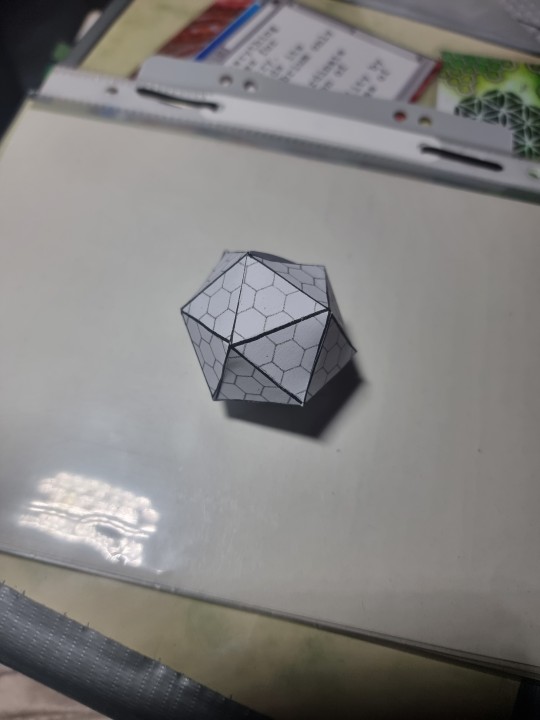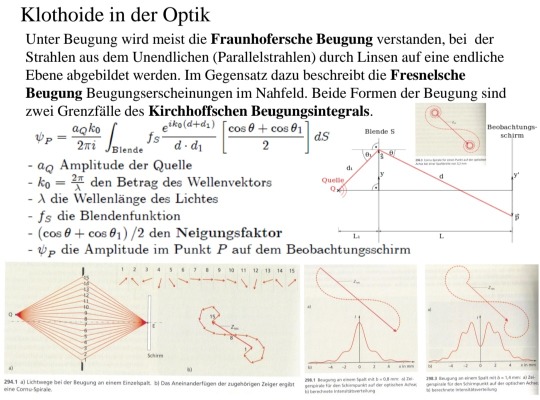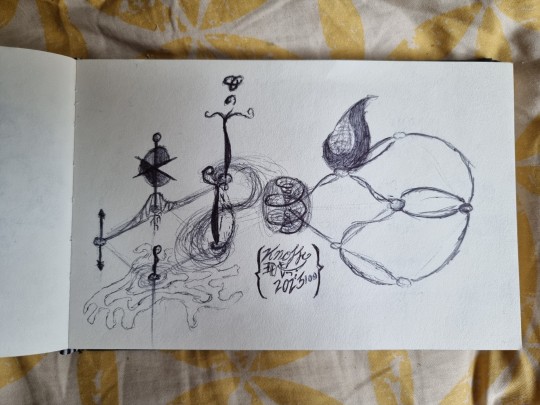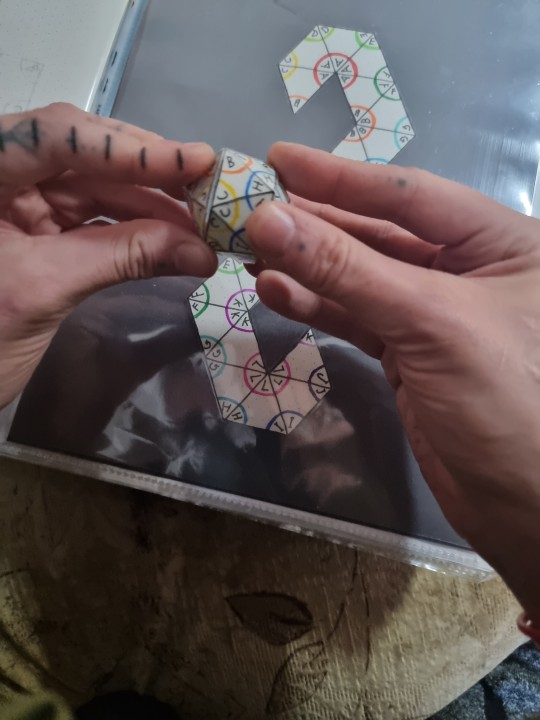#cornu spirals
Text
Icosahedron net - "coiling up"
This icosahedron net is really cool, as it is just like a "string of triangles" you can just roll up to form the icosahedron.

Result:

- - -- ---
The hexagon grid is really helpful for drawing equilateral triangles.
- - -- ---
It reminds me of this:
Diffraction - Source: German PDF [found at TU-dresden website]

...

#math#mathematics#icosahedron#icosahedra#regular polyhedra#regular polyhedron#hexagonal#hexagon#hexagon grid#diffraction#physics#euler spiral#spirals#spiral#clothoids#cornu spirals#cornu spiral#theoretical physics#STEM
61 notes
·
View notes
Text

Metamorphestra of entangled states of a life's unfolding and reshaping process - shapeshifting of the shapeshifter
[2023/09/24]
#metamorphestra#shapeshifter#shapeshifting#surrealism#diffraction#cornu spiral#trefoil knot#ballpoint pen#drawing#my art#knottys art#knotty et al#torus#helix#blurry#entanglement#entangled soup#metamorphosis#butterfly#moth#symbolism#change#life process#unfolding#morphogenesis#alteration#qubit#red thread of time#the red thread of time
14 notes
·
View notes
Text
OCTAfan's Obscure and Weird Musical Instruments Tournament Round 1 Part 4: Carnyx VS Cornu De Pompeii


The carnyx is a celtic wind instrument that's often used as a war horn. It was used during 200 BC to 200 AD. It's a mostly straight tube that is held vertically, with the bell being in the shape of an animal's head, usually a boar. It sounds mysterious, haunting and terrifying all at once and it is definitely a unique instrument.
The Cornu de Pompei is also a wind instrument that's basically a spiraling tube with a bar to support it. They're made of brass and is found in Rome, with two specimens being from Pompeii.
#OCTAfan says stuff#OCTAfan's Obscure and Weird Musical Instruments Tournament#Musical instruments#Carnyx#Cornu#Cornu de pompeii#Tumblr Tournament#Tumblr poll#Tournament poll
5 notes
·
View notes
Text
starting a new post trend for myself where i share what google spiral i went down because i got too invested in a minor detail for fic
today we have the la cornue château suprême range which, according to google, costs around $200k.
1 note
·
View note
Photo

Cornu • Gone Tomorrow
Dry-Erase Marker on whiteboard. Do not remove caption. GT0152
2 notes
·
View notes
Photo

Cornu’s Spiral. The theory of light. 1901.
Internet Archive
3K notes
·
View notes
Text
tma entities as fungi
The Flesh: postrodoma cornu-damae. looks like tongues

The Slaughter / The Hunt: bleeding tooth fungus. yes its really called that :)

The Vast: largest living organism on earth (honey fungus)

The Spiral: this cool spirally chanterelle mushroom

The Extinction: oyster mushrooms growing on oil-contaminated soil

The End: shaggy ink cap mushrooms

The Dark: coal fungus, ultimate goth

The Eye: couldn't find an actual fungus that looks like its staring at you so here's a meme

The Buried: the mushroom death suit that you are buried in

#here's what happens when two of my hyperfixations combine :):):):)#i know i didnt do all the entities but here ya go#tma#the magnus archives#i didnt like fungi at first but now theyre growing on me#fungi#fungus#tma entities#milo squawks
130 notes
·
View notes
Text
Saya pernah mengatakan bahwa saya sangat menyukai Putri duyung. Tak hanya itu namun saya menyukai makhluk-makhluk fiksi lainnya yang sering muncul di buku dongeng. makhluk-makhluk tersebut yaitu
1. Putri duyung

Putri duyung adalah makhluk air yang memiliki tubuh layaknya seorang perempuan dari pinggang sampai kepala, sedangkan bagian tubuhnya dari pinggang ke bawah menyerupai ikan. Putri duyung merupakan makhluk mitologis. Golongan makhluk separuh manusia separuh hewan.
3. Unicorn

Unikorn adalah makhluk mitologis yang berwujud kuda dengan sebuah tanduk di dahi. Jika kata cornus dihubungkan dengan kata horn, maka berarti tanduk. Biasanya, bulu Unicorn berwarna putih dan tanduknya berbentuk spiral.
4. Peri

Peri adalah istilah yang sering digunakan dalam cerita rakyat, dongeng, fiksi untuk menggambarkan makhluk yang memiliki kekuatan gaib yang kadang kala turut campur dalam urusan-urusan manusia
5. Pegasus

Pegasus adalah seekor kuda jantan bersayap yang merupakan putra Poseidon dan Medusa dalam mitologi Yunani.[1] Poseidon memerkosa Medusa sehingga Athena mengubah Medusa menjadi monster.
2 notes
·
View notes
Link
A genetic spin doctor sets snail shells to swirl clockwise, new research confirms. And the twist in this story comes at the beginning — when snail embryos are just single cells.
Though most pond snails (Lymnaea stagnalis) have shells that coil clockwise, a few have taken a left turn, curling counterclockwise. Researchers had strong evidence that a mutation in a gene called Lsdia1 caused the counterrevolution, but there was a possibility that the similar Lsdia2 gene might be involved. The two genes are 89.4 percent identical, so teasing out which was responsible was tricky.
Working at the Tokyo University of Science, chemist and biologist Reiko Kuroda and colleague Masanori Abe snipped Lsdia1 with the gene editor CRISPR/Cas9. The snip made a mutation in the gene that could be passed on to future generations. Snails that inherited two edited copies of the gene developed left-coiling, or sinistral, shells, say the researchers, who have relocated to the Chubu University in Kasugai, Japan.
The accomplishment — reported May 14 in Development — marks the first time researchers have been able to make heritable changes in snail genes, says evolutionary geneticist Angus Davison of the University of Nottingham in England. Teams led by Davison and Kuroda had previously published evidence independently that Lsdia1 is responsible for the twist, but the new paper provides the definitive proof, Davison says.

STAR SNAIL A lefty garden snail named Jeremy, pictured here atop a right-handed snail, became famous in 2016 when Angus Davison, an evolutionary geneticist at the University of Nottingham in England, announced a search for a left-handed mate. Similar to new research finding that mutations in the Lsdia1 gene cause pond snail shells to coil counterclockwise, Davison suggested that garden snails (Cornu aspersum) with left-swirling shells like Jeremy may have mutations in a gene with the same function as Lsdia1.
CREDIT: A. DAVISON
In the new study, Kuroda and Abe also found that Lsdia1 causes the cells’ internal scaffolding — the cytoskeleton — to skew to the left or right very early on, when snail embryos are just single cells. Finding that early twist solves a long-running mystery: When does asymmetry start?
Like snails, humans and many other organisms are asymmetrical, with internal organs growing on particular sides of the body. That asymmetry is necessary to fold intestines that are many times the length of the body in an orderly manner into a relatively small space, says Martin Blum, a developmental biologist at the University of Hohenheim in Stuttgart, Germany. Two genes, nodal and Pitx, are known to be involved in giving rise to that asymmetry, by being produced on only one side of the embryo. Gene-edited snail embryos turned on those genes in a pattern that is a mirror image to that of right-coiling snails, creating lefties, the researchers found.

THE LEFT GENERATION Before Jeremy died in 2017, the snail was paired with two other left-handed mates and produced offspring that were also left-handed, pictured here at about the size of the tip of a ballpoint pen. Garden snails prefer to mate with other snails, though they are hermaphrodites, with both male and female reproductive organs, and are capable of making offspring on their own.
CREDIT: A. DAVISON
“Now we know it starts in the symmetrical embryo,” Blum says. Lsdia1’s protein tugs on the cytoskeleton, which leads cells to divide in a spiral pattern. That somehow causes nodal and Pitx to turn on on one side of the embryo. “This riddle is solved,” he says, but there are still a few steps missing to connect how the skewing of cell division leads to activity of the two genes. Kuroda says she is working to fill in the details.
While the left-swirling version of Lsdia1 may help researchers understand asymmetry, it’s probably not very useful for snails in the wild. Left-swirling snails have trouble hatching and finding mates, Davison says. “If you’re a snail out in the wild, it’s game over for that mutation.”
#science#scied#sciblr#snail#snail shell#CRISPR#crispr-cas9#animals#genetics#development#lefty#counterclockwise#shells#garden snail#pond snail
26 notes
·
View notes
Text
Icosahedron net - slightly colorful visualization


Currently I am obsessed with polyhedra nets - and crafting tiny models and creating visualizations.
For this one I created a template for the net that somehow reminds me of the cornu spiral - as this kind of net can be "coiled up" to fold the polyhedron.
Furthermore, I used 12 colors for the 12 vertices - in a gradient-like arrangement (it starts at red and gradually follows the route at orange, yellow, green, blue, violet, and ends at pink.)





#icosahedron#icosahedra#icosahedron net#math visualization#math#mathematics#math art#polyhedra#polyhedron#regular polyhedron#regular polyhedra#platonic solids#polyhedra net#polyhedra grid#geometry#math models#geometric#mathy art#math and art#coiling#coil#cornu spiral#spirals#spiral#coiling up the icosahedron net#coiling up#mathy stuffy#mathy#math is beautiful#STEM
21 notes
·
View notes
Text
Outfit Details of the Bride and Bridal Party
The Wedding Dress: Clare Waight Keller for Givenchy
Ms. Meghan Markle’s wedding dress has been designed by the acclaimed British designer, Clare Waight Keller. Ms. Waight Keller last year became the first female Artistic Director at the historic French fashion house Givenchy.
After meeting Ms. Waight Keller in early 2018, Ms. Markle chose to work with her for her timeless and elegant aesthetic, impeccable tailoring, and relaxed demeanour. Ms. Markle also wanted to highlight the success of a leading British talent who has now served as the creative head of three globally influential fashion houses – Pringle of Scotland, Chloé, and now Givenchy.
Ms. Markle and Ms. Waight Keller worked closely together on the design. The dress epitomises a timeless minimal elegance referencing the codes of the iconic House of Givenchy and showcasing the expert craftsmanship of its world-renowned Parisian couture atelier founded in 1952.
The Design
True to the heritage of the house, the pure lines of the dress are achieved using six meticulously placed seams. The focus of the dress is the graphic open bateau neckline that gracefully frames the shoulders and emphasises the slender sculpted waist. The lines of the dress extend towards the back where the train flows in soft round folds cushioned by an underskirt in triple silk organza. The slim three-quarter sleeves add a note of refined modernity.
The Fabric
Following extensive research by Ms. Waight Keller in fabric mills throughout Europe, an exclusive double bonded silk cady was developed. Perfect for the round sculptural look required, the silk cady has a soft matt lustre whilst the bonding process and pure white colour chosen by Ms. Markle and Ms. Waight Keller bring a fresh modernity to the dress.
The Veil
Ms. Markle expressed the wish of having all 53 countries of the Commonwealth with her on her journey through the ceremony. Ms. Waight Keller designed a veil representing the distinctive flora of each Commonwealth country united in one spectacular floral composition.
The Commonwealth family of nations – of which Her Majesty The Queen is Head –will be a central part of Prince Harry’s and Ms. Markle’s official work following His Royal Highness’s appointment as Commonwealth Youth Ambassador. Ms. Markle wanted to express her gratitude for the opportunity to support the work of the Commonwealth by incorporating references to its members into the design of her wedding dress.
Significant time was spent researching the flora of each Commonwealth country and much care was taken by Ms. Waight Keller to ensure that every flower is unique.
The veil is five meters long and made from silk tulle with a trim of hand-embroidered flowers in silk threads and organza.
Each flower was worked flat, in three dimensions to create a unique and delicate design. The workers spent hundreds of hours meticulously sewing and washing their hands every thirty minutes to keep the tulle and threads pristine.
In addition to the flora of the Commonwealth, Ms. Markle also selected two personal favourites:
Wintersweet (Chimonanthus praecox), which grows in the grounds of Kensington Palace in front of Nottingham Cottage, and the California Poppy (Eschscholzia californica) the State flower from Ms. Markle’s place of birth, California.
Symmetrically placed at the very front of the veil, crops of wheat are delicately embroidered and blend into the flora, to symbolise love and charity.
A selection of flora distinctive from every member state of the Commonwealth is listed below:
AFRICA:
Botswana - Ear of Sorghum and Cat’s Claw (Uncaria tomentosa)
Cameroon - Red Stinkwood (Prunus africana)
Gambia - White Variety Orchid
Ghana - Caladium (Caladium)
Kenya - The Tropical Orchid
Lesotho - Spiral Aloe (Aloe polyphylla)
Malawi - Lotus (Nymphea lotus)
Mauritius - Trochetia Boutoniana
Mozambique - Maroon Bell Bean (Markhamia zanzibarica)
Namibia - Welwitschia (Welwitschia mirabilis)
Nigeria - Yellow Trumpet (Costus spectabilis)
Rwanda - Torch Lily (Kniphofia uvaria)
Seychelles - Tropicbird orchid (Angraecum eburnum)
Sierra Leone - Scadoxus (Scadoxus cinnabarinus)
South Africa - Protea (Protea cynaroides)
Swaziland - Fire Heath (Erica cerinthoides)
Uganda - Desert rose (Adenium obesum)
United Republic of Tanzania - African violet (Saintpaulia)
Zambia - Bougainvillea (Bougainvillea)
ASIA:
Bangladesh - White Water Lily ( Sada shapla)
Brunei Darussalam - Simpor (Dillenia suffruticosa)
India - Indian Lotus (Nelumbo nucifers gaertn)
Malaysia - Bunga Raya Hibiscus (Hibiscus rosa sinensis)
Pakistan - Jasmine (Jasminum officinale)
Singapore - Vanda miss Joaquim Orchid (Miss Joaquim)
Sri Lanka - Blue Water Lily (Nymphaea nouchali)
CARIBBEAN & AMERICAS:
Antigua and Barbuda - Agave (Agave karatto)
Bahamas - Yellow Elder (Tecoma stans)
Barbados - The pride of Barbados (Caesalpinia pulcherrima)
Belize - The Black Orchid (Encyclia cochleata)
Canada - Bunchberry (Cornus canadensis)
Dominica - Carib Wood (Sabinea carinalis)
Grenada - Bougainvillea (Nyctaginaceae)
Guyana - Victoria Regia Water Lily (Victoria amazonica)
Jamaica - Lignum Vitae (Guiacum officinale)
Saint Lucia - The rose and the marguerite
St Kitts and Nevis - Poinciana (Delonix regia )
St Vincent & the Grenadines - Soufriere Tree (Spachea perforatais)
Trinidad & Tobago - Chaconia (Warszewiczia coccinea)
EUROPE:
Cyprus - Cyclamen Cyprium (Cyclamen cyprium)
Malta - Maltese centaury (Cheirolophus crassifolius
UNITED KINGDOM:
England - Rose
Wales - Daffodil (Narcissus)
Northern Ireland - Flax flower
Scotland - Thistle
PACIFIC:
Australia - Golden wattles (Acacia pycnantha)
Fiji - Tagimaucia (Medinilla waterhousei)
Kiribati - Bidens Kiribatiensis
Nauru - Calophyllum
New Zealand - Kowhai (Sophora microphylla)
Papua - Sepik Blue Orchid (Dendrobium lasianthera)
Samoa - Teuila (Alpinia purpurata)
Solomon Islands - Hibiscus (Hibiscus)
Tonga - Heilala (Garcinia sessilis)
Tuvalu - Plumeria (Plumeria frangipans)
Vanuatu - Anthurium (Anthurium)
Jewellery
The veil is held in place by Queen Mary's diamond bandeau tiara, lent to Ms. Markle by The Queen. The diamond bandeau is English and was made in 1932, with the centre brooch dating from 1893.
The bandeau, which is made of diamonds and platinum, is formed as a flexible band of eleven sections, pierced with interlaced ovals and pavé set with large and small brilliant diamonds. The centre is set with a detachable brooch of ten brilliant diamonds.
The diamond bandeau was made for Queen Mary and specifically designed to accommodate the centre brooch. This brooch was given as a present to the then Princess Mary in 1893 by the County of Lincoln on her marriage to Prince George, Duke of York. The bandeau and the brooch were bequeathed by Queen Mary to The Queen in 1953.
The Bride is wearing earrings and bracelet made by Cartier.
Wedding Shoes
The wedding shoes are based on a Givenchy refined pointed couture design made of a silk duchess satin.
The Bride’s Bouquet
Prince Harry handpicked several flowers yesterday from their private garden at Kensington Palace to add to the bespoke bridal bouquet designed by florist Philippa Craddock.
The spring blooms include Forget-Me-Nots which were Diana, Princess of Wales’ favourite flower. The couple specifically chose them to be included in Ms. Markle’s bouquet to honour the memory of the late Princess on this special day.
The Bride's bouquet is a petite design, pulled together in a gentle, ethereal, relaxed style with delicate blooms also including scented sweet peas, lily of the valley, astilbe, jasmine and astrantia, and sprigs of myrtle, all bound with a naturally dyed, raw silk ribbon.
The myrtle sprigs are from stems planted at Osborne House on the Isle of Wight, by Queen Victoria in 1845, and from a plant grown from the myrtle used in The Queen’s wedding bouquet of 1947.
The tradition of carrying myrtle begun after Queen Victoria was given a nosegay containing myrtle by Prince Albert’s grandmother during a visit to Gotha in Germany. In the same year, Queen Victoria and Prince Albert bought Osborne House as a family retreat, and a sprig from the posy was planted against the terrace walls, where it continues to thrive today.
The myrtle was first carried by Queen Victoria's eldest daughter, Princess Victoria, when she married in 1858.
Bridal Hair and Make-Up
Ms. Markle's hair was styled by Serge Normant, with make-up by long-time friend and make-up artist Daniel Martin.
Bridesmaids’ Dresses
Clare Waight Keller designed the six young Bridesmaids’ dresses in the Givenchy Haute Couture Atelier in Paris.
The dresses were designed to have the same timeless purity as Ms. Markle's dress.
Each dress is sculpted in Ivory silk Radzimir, and is high-waisted with short puff sleeves and hand finished with a double silk ribbon detail tied at the back in a bow. The Bridesmaids’ dresses include pockets and pleated skirts to create a relaxed and luxurious silhouette.
The Bridesmaids are wearing white leather Aquazurra shoes; each pair is monogrammed with the Bridesmaids initials, and the wedding date. The shoes are a gift from Ms. Markle to the young ladies as a keepsake of the special day.
Bridesmaids’ Flowers
The bridesmaids each have flower crowns selected by Prince Harry and Ms. Markle, which have been designed by florist Philippa Craddock.
The Bridesmaids' flowers replicate the flowers used in the bridal bouquet.
Page Boys' Uniforms
The four Pages are wearing a miniature version of the Blues and Royals frockcoat. The uniform draws its insignia from the Blues and Royals, which is an old Regiment of The Duke of Cambridge and Prince Harry. Both are also wearing Blues and Royals frockcoats for the Wedding Day.
The frockcoats are made from blue doeskin, single-breasted in style with a stand-up collar and completed with figured braiding of Regimental pattern. The figured braiding has been scaled down for the Pages, as otherwise it would have gone above their shoulders.
As a special memento, each Page has their initials embroidered in gold on their shoulder straps. The Pages are not wearing hats or white waist belts for practical reasons.
Their leg garments are made from blue/black wool barathea with three-quarter scarlet stripes fastened with a leather strap.
The uniforms were cut and made by the tailors Dege & Skinner in Savile Row.
Mother of the Bride's Dress
Ms. Ragland wears a custom dress and day coat designed by creative directors of Oscar de la Renta, Fernando Garcia and Laura Kim.
Ms. Ragland's shoes are designed by Edgardo Osorio of Aquazurra, and her custom hat was designed exclusively for her by British milliner Stephen Jones, O.B.E., whom Ms. Markle has worked closely with since moving to the UK.
Stephen Jones was also commissioned by Ms. Markle to create custom hats for several of her closest friends.
LINK
440 notes
·
View notes
Text
Au royaume des grains de sable - Saber Lahmidi
Au royaume des grains de sable – Saber Lahmidi
Les grains fins, fils de quartz vieilli
Les bons compagnons d’arbrisseau
Scrutent l’horizon vacillant
Imitent un cadeau du ciel
Sept nuages, un sacrifice
Dégouline du bleu sacré
Sur cette vallée coriace
Au royaume des grains de sable.
Le vieux brun cornu en spirale,
Résident du val reculé,
S’étend sur le sable et s’en fiche
Des grains anticipant le bien.
Du carnaval de cette année
Il vaut mieux…

View On WordPress
1 note
·
View note
Text
E2449
escargot d'eau escargot d'eau escargot d'eau escargot d'eau haut bas haut bas haut bas haut bas haut bas haut bas haut nu nu nu nu nu nu nu nu nu nu nu nu nu nu nu nu nu nu nu nu la coquille la coquille la coquille la coquille la coquille la coquille
cornes cornes cornes cornes cornes cornes cornes la cornue stalactite se love limace sans toit spirale glisse escargot d'eau escargot là escargot si escargot u goutte à goutte stalagmite au plafond faune toutes espèces coquilles en l'air escargot ci là lilalère la bayadère
prous
0 notes
Text
My mustache is annoying. It won’t stay short enough not to get in my mouth, but no matter how long I leave it it won’t grow long enough to wax into a Cornu spiral either
0 notes
Photo

👑 #RoyalWedding 💍 #TheDuchessOfSussex veil featured flowers representing all 53 Commonwealth countries. Delicate hand embroidery embellishes the 16- foot-long piece of silk tulle. Some of the blooms include hibiscus for the Solomon Islands, black orchids for Belize, and of course English roses. Made of layers of ivory, silk tulle and a casual five meters long, the veil took ateliers hundreds of hours to create. According to the BBC, the dressmakers were required to wash their hands every 30 minutes while working on the stitching and threaded using silk. A list of each of the flora from every member state of the Commonwealth is listed below: AFRICA: Botswana - Ear of Sorghum and Cat’s Claw (Uncaria tomentosa) Cameroon - Red Stinkwood (Prunus africana) Gambia - White Variety Orchid Ghana - Caladium (Caladium) Kenya - The Tropical Orchid Lesotho - Spiral Aloe (Aloe polyphylla) Malawi - Lotus (Nymphea lotus) Mauritius - Trochetia Boutoniana Mozambique - Maroon Bell Bean (Markhamia zanzibarica) Namibia - Welwitschia (Welwitschia mirabilis) Nigeria - Yellow Trumpet (Costus spectabilis) Rwanda - Torch Lily (Kniphofia uvaria) Seychelles - Tropicbird orchid (Angraecum eburnum) Sierra Leone - Scadoxus (Scadoxus cinnabarinus) South Africa - Protea (Protea cynaroides) Swaziland - Fire Heath (Erica cerinthoides) Uganda - Desert rose (Adenium obesum) United Republic of Tanzania - African violet (Saintpaulia) Zambia - Bougainvillea (Bougainvillea) ASIA: Bangladesh - White Water Lily ( Sada shapla) Brunei Darussalam - Simpor (Dillenia suffruticosa) India - Indian Lotus (Nelumbo nucifers gaertn) Malaysia - Bunga Raya Hibiscus (Hibiscus rosa sinensis) Pakistan - Jasmine (Jasminum officinale) Singapore - Vanda miss Joaquim Orchid (Miss Joaquim) Sri Lanka - Blue Water Lily (Nymphaea nouchali) CARIBBEAN & AMERICAS: Antigua and Barbuda - Agave (Agave karatto) Bahamas - Yellow Elder (Tecoma stans) Barbados - The pride of Barbados (Caesalpinia pulcherrima) Belize - The Black Orchid (Encyclia cochleata) Canada - Bunchberry (Cornus canadensis) Dominica - Carib Wood (Sabinea carinalis) Grenada - Bougainvillea (Nyctaginaceae) Guyana - Victoria Regia Water Lily (Victoria amazonica) Jamaica - Lignum Vitae (Guiacum officinale) Saint Lucia - The rose and the marguerite St Kitts and Nevis - Poinciana (Delonix regia ) St Vincent & the Grenadines - Soufriere Tree (Spachea perforatais) Trinidad & Tobago - Chaconia (Warszewiczia coccinea) EUROPE: Cyprus - Cyclamen Cyprium (Cyclamen cyprium) Malta - Maltese centaury (Cheirolophus crassifolius UNITED KINGDOM: England - Rose Wales - Daffodil (Narcissus) Northern Ireland - Flax flower Scotland - Thistle PACIFIC: Australia - Golden wattles (Acacia pycnantha) Fiji - Tagimaucia (Medinilla waterhousei) Kiribati - Bidens Kiribatiensis Nauru - Calophyllum New Zealand - Kowhai (Sophora microphylla) Papua - Sepik Blue Orchid (Dendrobium lasianthera) Samoa - Teuila (Alpinia purpurata) Solomon Islands - Hibiscus (Hibiscus) Tonga - Heilala (Garcinia sessilis) Tuvalu - Plumeria (Plumeria frangipans) Vanuatu - Anthurium (Anthurium)
5 notes
·
View notes
Photo

Cornu’s Spiral #1911 #optics #diffraction #curvature #physics #light https://www.instagram.com/p/CFKPQu6B_XE/?igshid=19792bkkcw7zz
0 notes